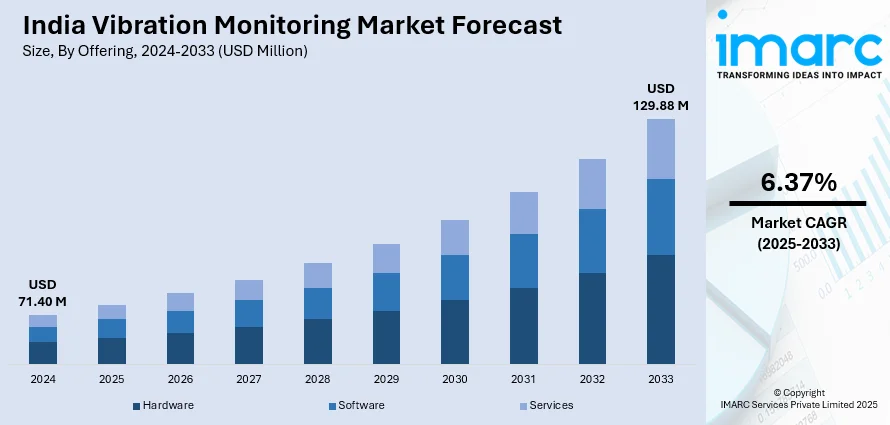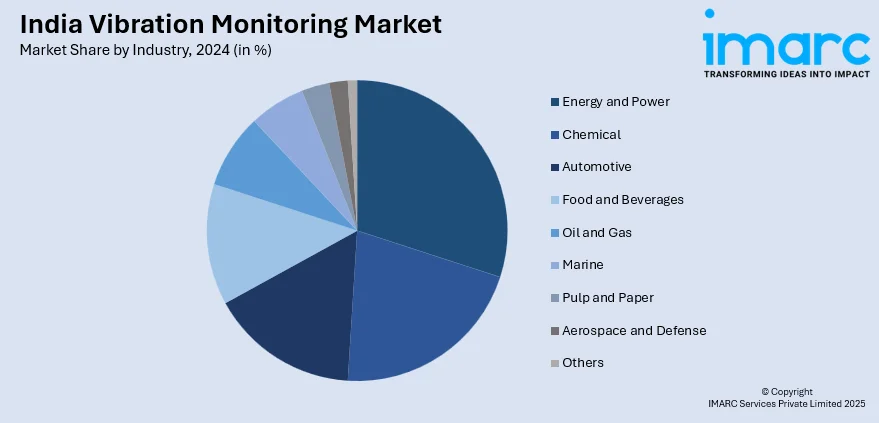
India Vibration Monitoring Market Size, Share, Trends and Forecast by Offering, Monitoring Process, System Type, Industry, and Region, 2025-2033
India Vibration Monitoring Market Overview:
The India vibration monitoring market size reached USD 71.40 Million in 2024. Looking forward, IMARC Group expects the market to reach USD 129.88 Million by 2033, exhibiting a growth rate (CAGR) of 6.37% during 2025-2033. The market is being primarily driven by the rise of industrial automation, the implementation of stringent workplace safety regulations, the rapid expansion of renewable energy projects, and the increased adoption of predictive maintenance technologies across various sectors, such as manufacturing, oil and gas, power generation, and transportation.
|
Report Attribute
|
Key Statistics
|
|---|---|
|
Base Year
|
2024 |
|
Forecast Years
|
2025-2033
|
|
Historical Years
|
2019-2024
|
| Market Size in 2024 | USD 71.40 Million |
| Market Forecast in 2033 | USD 129.88 Million |
| Market Growth Rate 2025-2033 | 6.37% |
India Vibration Monitoring Market Trends:
Growth of Industrial Automation and Smart Manufacturing
India's vibration monitoring market is growing at a strong pace, owing to the increasing popularity of industrial automation and smart manufacturing. With industries shifting toward Industry 4.0, there is a developing need for real-time monitoring of machine health to maintain efficiency in operations. The India industry 4.0 market is projected to reach USD 17.4 billion by 2033, exhibiting a growth rate (CAGR) of 12.40% during 2025-2033. Automated manufacturing plants and digitally connected supply chains are becoming the standard in sectors like automotive, aerospace, and manufacturing. Vibration monitoring systems now incorporate IoT-capable sensors that offer real-time data insights, enabling industries to detect equipment failure in advance and minimize unplanned downtimes. In addition to this, numerous sectors are adopting predictive maintenance practices in place of the conventional reactive maintenance, which has propelled the need for wireless vibration sensors and AI-based diagnostic solutions. Organizations are spending on high-end condition monitoring solutions to boost safety, optimize resource utilization, and improve production efficiency. Favorable initiatives by government bodies, such as the "Make in India" initiative, are also promoting the utilization of high-tech solutions, further driving the market growth.

To get more information of this market, Request Sample
Stringent Regulations for Workplace Safety and Equipment Maintenance
Another key driver of the India vibration monitoring market is the implementation of stringent regulations regarding workplace safety and equipment maintenance. Government bodies and safety organizations have been imposing stricter compliance standards in an effort to avoid workplace incidents and equipment failures. Several industries, such as oil and gas, power generation, and mining, are subject to strict safety audits that include requirements for implementing vibration monitoring solutions to identify budding hazards early. The Directorate General of Mines Safety (DGMS) and the Bureau of Indian Standards (BIS) have established standards that focus on continuous monitoring of heavy equipment to provide safety for workers and protection for the environment. These regulations require industries to spend money on very sensitive vibration monitoring systems that are capable of detecting mechanical imbalances, misalignments, and initial wear and tear before total failures. Additionally, firms that do not comply with these safety norms are subjected to severe penalties and plant shutdowns. This has resulted in rising investments in cloud-based vibration analysis solutions, which allow firms to comply with regulatory norms cost-effectively while improving productivity at the same time. With regulatory agencies continuing to tighten safety regulations, the need for high-precision vibration monitoring solutions will continue to rise.
India Vibration Monitoring Market Segmentation:
IMARC Group provides an analysis of the key trends in each segment of the market, along with forecasts at the region/country level for 2025-2033. Our report has categorized the market based on offering, monitoring process, system type, and industry.
Offering Insights:
- Hardware
- Software
- Services
The report has provided a detailed breakup and analysis of the market based on the offering. This includes hardware, software, and services.
Monitoring Process Insights:
- Online
- Portable
A detailed breakup and analysis of the market based on the monitoring process have also been provided in the report. This includes online and portable.
System Type Insights:
- Embedded Systems
- Vibration Meters
- Vibration Analysers
The report has provided a detailed breakup and analysis of the market based on the system type. This includes embedded systems, vibration meters, and vibration analysers.
Industry Insights:

- Energy and Power
- Chemical
- Automotive
- Food and Beverages
- Oil and Gas
- Marine
- Pulp and Paper
- Aerospace and Defense
- Others
A detailed breakup and analysis of the market based on the industry have also been provided in the report. This includes energy and power, chemical, automotive, food and beverages, oil and gas, marine, pulp and paper, aerospace and defense, and others.
Regional Insights:
- North India
- South India
- East India
- West India
The report has also provided a comprehensive analysis of all the major regional markets, which include North India, South India, East India, and West India.
Competitive Landscape:
The market research report has also provided a comprehensive analysis of the competitive landscape. Competitive analysis such as market structure, key player positioning, top winning strategies, competitive dashboard, and company evaluation quadrant has been covered in the report. Also, detailed profiles of all major companies have been provided.
India Vibration Monitoring Market News:
- March 2025: The Wayanad Tunnel Road project received clearance with strict conditions, including mandatory vibration monitoring, owing to the region’s landslide risks. Four real-time ground vibration monitoring systems will be installed and low-impact tunneling techniques used to protect the fragile Western Ghats.
- August 2024: Scientists from India’s NIT Rourkela, along with researchers from Saudi Arabia and the UAE, developed a new meta-structure that effectively absorbs and reduces vibrations in machines and instruments. This innovation enhances vibration control across industries like manufacturing, energy, and transportation, making machines more efficient and durable. As India’s industrial sector expands, the adoption of advanced vibration mitigation technologies is increasing, driving demand in the vibration monitoring market.
- May 2024: The National High-Speed Rail Corporation Limited (NHSRCL) announced that it would integrate indigenous technological solutions under the 'Make-in-India' initiative for the country’s first bullet train project between Mumbai and Ahmedabad, which is expected to open by 2026. This includes deploying sensitive geotechnical instruments like vibration monitors to ensure the safety of structures around construction sites. The increased use of such monitoring devices in large-scale infrastructure projects is also propelling growth in India's vibration monitoring market.
India Vibration Monitoring Market Report Coverage:
| Report Features | Details |
|---|---|
| Base Year of the Analysis | 2024 |
| Historical Period | 2019-2024 |
| Forecast Period | 2025-2033 |
| Units | Million USD |
| Scope of the Report | Exploration of Historical Trends and Market Outlook, Industry Catalysts and Challenges, Segment-Wise Historical and Future Market Assessment:
|
| Offerings Covered | Hardware, Software, Services |
| Monitoring Processes Covered | Online, Portable |
| System Types Covered | Embedded Systems, Vibration Meters, Vibration Analysers |
| Industries Covered | Energy and Power, Chemical, Automotive, Food and Beverages, Oil and Gas, Marine, Pulp and Paper, Aerospace and Defense, Others |
| Regions Covered | North India, South India, East India, West India |
| Customization Scope | 10% Free Customization |
| Post-Sale Analyst Support | 10-12 Weeks |
| Delivery Format | PDF and Excel through Email (We can also provide the editable version of the report in PPT/Word format on special request) |
Key Questions Answered in This Report:
- How has the India vibration monitoring market performed so far and how will it perform in the coming years?
- What is the breakup of the India vibration monitoring market on the basis of offering?
- What is the breakup of the India vibration monitoring market on the basis of monitoring process?
- What is the breakup of the India vibration monitoring market on the basis of system type?
- What is the breakup of the India vibration monitoring market on the basis of industry?
- What are the various stages in the value chain of the India vibration monitoring market?
- What are the key driving factors and challenges in the India vibration monitoring market?
- What is the structure of the India vibration monitoring market and who are the key players?
- What is the degree of competition in the India vibration monitoring market?
Key Benefits for Stakeholders:
- IMARC’s industry report offers a comprehensive quantitative analysis of various market segments, historical and current market trends, market forecasts, and dynamics of the India vibration monitoring market from 2019-2033.
- The research report provides the latest information on the market drivers, challenges, and opportunities in the India vibration monitoring market.
- Porter's five forces analysis assist stakeholders in assessing the impact of new entrants, competitive rivalry, supplier power, buyer power, and the threat of substitution. It helps stakeholders to analyze the level of competition within the India vibration monitoring industry and its attractiveness.
- Competitive landscape allows stakeholders to understand their competitive environment and provides an insight into the current positions of key players in the market.
Need more help?
- Speak to our experienced analysts for insights on the current market scenarios.
- Include additional segments and countries to customize the report as per your requirement.
- Gain an unparalleled competitive advantage in your domain by understanding how to utilize the report and positively impacting your operations and revenue.
- For further assistance, please connect with our analysts.
 Request Customization
Request Customization
 Speak to an Analyst
Speak to an Analyst
 Request Brochure
Request Brochure
 Inquire Before Buying
Inquire Before Buying




.webp)




.webp)












